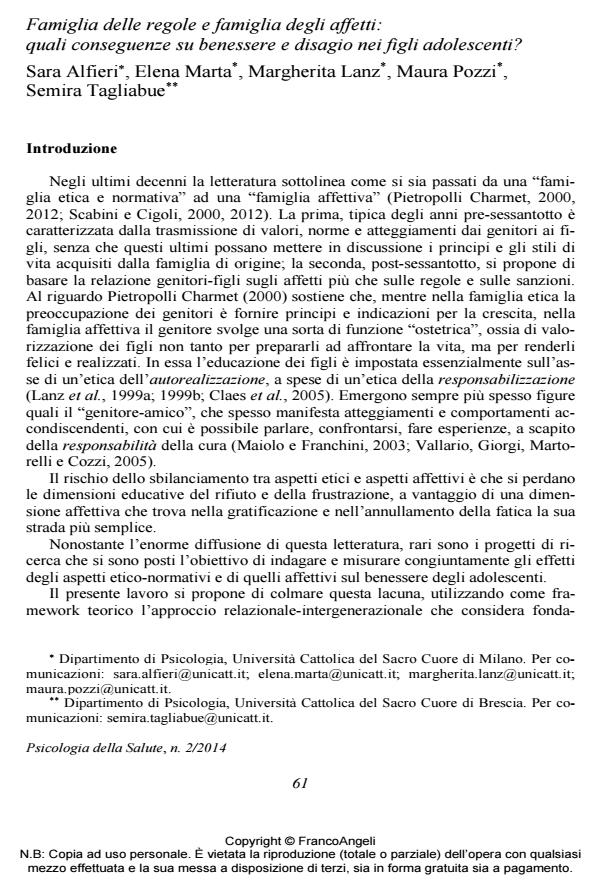Famiglia delle regole e famiglia degli affetti: quali conseguenze su benessere e disagio nei figli adolescenti?
Journal title PSICOLOGIA DELLA SALUTE
Author/s Sara Alfieri, Elena Marta, Margherita Lanz, Maura Pozzi, Semira Tagliabue
Publishing Year 2014 Issue 2014/2
Language Italian Pages 18 P. 61-78 File size 182 KB
DOI 10.3280/PDS2014-002005
DOI is like a bar code for intellectual property: to have more infomation
click here
Below, you can see the article first page
If you want to buy this article in PDF format, you can do it, following the instructions to buy download credits

FrancoAngeli is member of Publishers International Linking Association, Inc (PILA), a not-for-profit association which run the CrossRef service enabling links to and from online scholarly content.
- Motivations and contents of parent-child value transmission Daniela Barni, Silvia Donato, Rosa Rosnati, Francesca Danioni, in Journal of Prevention & Intervention in the Community /2017 pp.180
DOI: 10.1080/10852352.2016.1198125 - Families and Social Media Use: The Role of Parents’ Perceptions about Social Media Impact on Family Systems in the Relationship between Family Collective Efficacy and Open Communication Fortuna Procentese, Flora Gatti, Immacolata Di Napoli, in International Journal of Environmental Research and Public Health /2019 pp.5006
DOI: 10.3390/ijerph16245006 - Children’s voices through teachers’ stories Elisabetta Musi, Margareth Eilifsen, in Indo-Pacific Journal of Phenomenology e2363174/2024
DOI: 10.1080/20797222.2024.2363174 - Adaptation of the Snyder’s dispositional Hope Scale for Italian adolescents Sara Alfieri, Alessandro Quartiroli, Douglas Baumann, in Current Psychology /2023 pp.5662
DOI: 10.1007/s12144-021-01875-5 - A qualitative evaluation of a preventive intervention for parents: The Groups for Family Enrichment_Parent version (GFE_P) Anna Bertoni, Silvia Donato, Antonella Morgano, Raffaella Iafrate, Rosa Rosnati, in Journal of Prevention & Intervention in the Community /2017 pp.215
DOI: 10.1080/10852352.2016.1198135 - Social Representation of Family: A Comparative Study on Italian Young and Older Adults Pozzi Maura, Fasanelli Roberto, Marta Elena, Ellena Adriano Mauro, Virgilio Giuseppe, Di Taranto Adriana, Pistoni Carlo, in Journal of Family Issues /2022 pp.752
DOI: 10.1177/0192513X21994160 - Conoscenze e comportamenti degli adolescenti in ambito affettivo-sessuale: una ricerca esplorativa Elena Canzi, Miriam Parise, Laura Ferrari, Maria Giulia Olivari, in RICERCHE DI PSICOLOGIA 2/2020 pp.575
DOI: 10.3280/RIP2020-002006 - Gratitude as a Variable of Mediation between Parental Support and Self-Esteem in Adolescence Sara Alfieri, Semira Tagliabue, Elena Marta, Giovanni Aresi, Margherita Lanz, Maura Pozzi, in Journal of Child and Family Studies /2018 pp.1394
DOI: 10.1007/s10826-017-1001-4 - (Dis)obedience in U.S. American young adults: A new way to describe authority relationships Maura Pozzi, Alessandro Quartiroli, Sara Alfieri, Francesco Fattori, Carlo Pistoni, in Europe’s Journal of Psychology /2018 pp.404
DOI: 10.5964/ejop.v14i2.1314
Sara Alfieri, Elena Marta, Margherita Lanz, Maura Pozzi, Semira Tagliabue, Famiglia delle regole e famiglia degli affetti: quali conseguenze su benessere e disagio nei figli adolescenti? in "PSICOLOGIA DELLA SALUTE" 2/2014, pp 61-78, DOI: 10.3280/PDS2014-002005